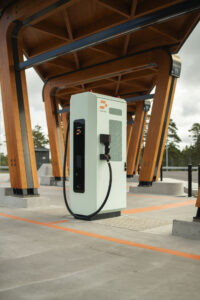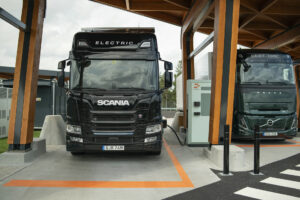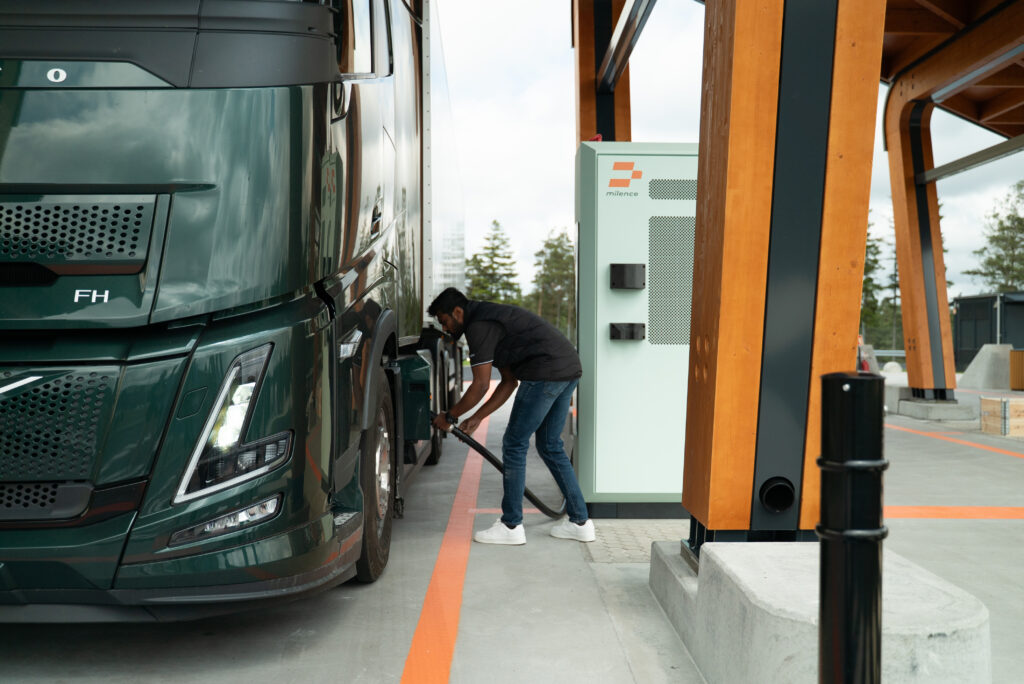In 2023, we explored how Megawatt Charging System (MCS) could transform the future of heavy-duty electric transport. That vision is now taking shape in the Milence network, with three operational MCS hubs in Zwolle (Netherlands), Port of Antwerp-Bruges (Belgium), and Landvetter (Sweden) — and Europe’s first MCS corridor connecting Antwerp to Stockholm.
Delivering up to 1.44 MW, MCS makes high-power charging fast and reliable, so that infrastructure never holds eTrucks back. As a truck-dedicated standard, MCS brings higher reliability and safety — even at MW charging speeds. It is this combination of speed and efficiency that makes MCS critical for decarbonising long-haul freight and lowering total cost of ownership (TCO).
Yet despite the progress, persistent myths about MCS continue to cloud its potential. Drawing on real-world deployments, close industry collaboration, and our experience at the forefront of Europe’s MCS rollout, we aim to set the record straight — and show why MCS belongs at the heart of road transport decarbonisation.
Myth 1: MCS is just a bigger version of CCS
It’s easy to think of the Megawatt Charging System (MCS) as simply a scaled-up Combined Charging System (CCS). After all, both charge electric vehicles charging technologies. But that’s where the similarities end.
MCS is purpose-created for heavy-duty vehicles like planes, boats and trucks, not adapted from passenger car technology. The difference shows in the numbers, too. While most CCS chargers today deliver up to 350–400 kW, MCS is designed for up to 3.75 MW, with 1.5 MW expected to become the standard for truck charging. In practice, this means MCS can deliver megawatt-hour–level energy in less than an hour — making it technically possible to recharge even a truck with a 1 MWh battery, if properly designed, within a single rest break.

MCS also runs on the latest ISO 15118-20 protocol which enables features like secure plug-and-charge and advanced energy management. More importantly, MCS introduces an entirely new communication platform (built on automotive ethernet, IEC 61851-23-3, and ISO 15118-20) — which is one of the key differences from CCS. Unlike the CCS platform, which can struggle with reliability at very high charging powers, the MCS communication platform was specifically chosen to ensure a stable operation even at megawatt levels.
The placement of the truck’s charging inlet is also standardised. While this might sound minor, it means infrastructure can be built more efficiently and drivers can connect without difficult manoeuvring.
In other words, MCS is a technology built from the ground up for the realities of freight transport — and with drivers in mind.
Myth 2: MCS “destroys” truck batteries faster, leading to higher costs
High charging power often gets blamed for damaging batteries faster. The myth implies that plugging into an MCS charger means you’re trading speed for shorter battery life and higher replacement costs.
The reality is different, though. MCS is engineered with battery health in mind, using advanced thermal management and carefully controlled charging speeds (C-rates). This means it carefully manages the charging speed to match what the battery can safely handle, preventing overheating or excessive wear. In fact, industries like consumer electronics and passenger cars already operate at C-rates far above those foreseen for MCS. This provides strong evidence that higher charging powers, when managed correctly, do not necessarily shorten battery lifetime.
Chemistry plays a big role, too. Modern LFP (Lithium Iron Phosphate) and NMC (Nickel Manganese Cobalt) batteries are built to handle high-power charging with minimal degradation — as long as the process is managed properly. MCS ensures that.
It also turns out that faster charging doesn’t just save time, it can actually lower your total cost of ownership. By reducing downtime, fleets can run smaller battery packs while keeping vehicles on the road more often — which means less idle capital and better operational efficiency.
High power doesn’t have to mean high wear. With the right technology and management, it’s simply high performance.
Myth 3: MCS is unstable or unproven technically
Some think Megawatt Charging System technology is still experimental, unreliable in real-world conditions and not ready for prime time. But in reality, MCS has already moved well beyond the lab.
The industry has already progressed from development and power testing into verification, with extensive real-world trials underway. Events like the CharIN Testival — where Milence and Power Electronics, among others, joined forces — bring together manufacturers, OEMs, and operators to test interoperability and iron out any issues before mass rollout.
Confidence is also reflected in the market. Major players such as Power Electronics, Alpitronic, and ABB have already launched MCS market-ready products, signalling that the standard is mature enough for commercial deployment. At the same time, more and more charging providers are beginning to roll out MCS capability at their sites, a clear trend toward adoption across the industry.
The last big milestone is fine-tuning the communication platform. This includes enabling all ISO 15118-20 use cases, such as mutual TLS 1.3 encryption and robust certificate management, which are critical for secure and seamless charging. These developments are well underway and will soon clear the path for wide-scale implementation.
MCS is not a concept anymore. It’s a proven, tested technology, with the final polish happening now.
Myth 4: MCS is too expensive and impractical
A common concern is that Megawatt Charging System infrastructure is too costly to build and therefore unrealistic for large-scale deployment.
In reality, strategic placement changes the equation entirely. By focusing on key freight corridors — like the EU’s TEN-T network — operators can achieve maximum usage and return on investment. As we uncover in our latest white paper “The Readiness of Public Charging Infrastructure for Electric Long-Haul Trucks”, just 1,100 public MCS points could support between 6,000 and 20,000 electric trucks today, with the potential to grow to 8,500–14,000 points by 2030.
On the infrastructure side, the charging architecture Milence is developing with its partners will make the deployment cost of MCS and CCS comparable in the future. In fact, as the number of MCS connectors grows, deployment costs are expected to drop below CCS. That’s because our architecture optimises power use and reduces the need for redundant, expensive power electronics.
On the vehicle side, the MCS inlet itself is only a few hundred euros more than a CCS inlet. And when charging at Milence hubs across Europe, our standard flat rate of €0.399/kWh (excl. VAT) applies no matter if trucks use a CCS or MCS charger.
The cost barrier is also being addressed through EU support, such as the AFIF funding that is helping accelerate MCS development across Europe.
MCS offers more than just speed. Making a full charge possible in as little as 30 minutes, it integrates directly into existing logistics operations, minimising downtime and disruption, which brings operators higher efficiency and stronger competitiveness for the transport sector.
Myth 5: MCS will overwhelm power grids
It’s true that megawatt-level charging draws a lot of power — but that doesn’t mean it will destabilise electricity grids.
In practice, MCS deployment is strategic and gradual. Stations are planned along key freight corridors (e.g., every 100 km) to spread demand and avoid creating concentrated load hotspots.
Operators like Milence also use on-site battery storage and smart charge management systems to smooth out peak demand if needed. This means charging sessions can be scheduled and balanced in real time, easing the impact on the local grid.
Multiple real-world pilots and studies, including those cited in the IEA’s “Electricity Grids and Secure Energy Transitions” report, show that with proper planning, MCS can scale without compromising grid stability, while supporting the widespread adoption of heavy-duty EVs.
Taking the lead in MCS deployment
At Milence, we’re actively building the future of truck charging. We already have three operational hubs offering MCS charging, giving long-haul operators real-world access to megawatt-level speeds. Our commitment to making MCS a reality is backed by hands-on proof: from successful interoperability tests with the Mercedes-Benz eActros 600 and the MAN eTGS trucks to public MCS demonstrations with Volvo and Scania at Landvetter in June 2025.

Behind the scenes, our Interoperability Lab in Arnhem, the Netherlands, is ground zero for this progress. Here, we work directly with OEMs like MAN Truck & Bus to validate MCS technology, test communication protocols, and ensure that when trucks arrive at our hubs, charging just works.
Our corridor-first strategy means MCS hubs are strategically placed along Europe’s busiest freight arteries — including TEN-T corridors — so fleets can cover long distances with confidence. And because the transition to full megawatt charging won’t happen overnight, we’re integrating both CCS and MCS at our sites, giving operators the flexibility they need as their fleets evolve.
For Milence, MCS is a cornerstone of a zero-emission logistics network that’s truly ready for the demands of European freight.
Conclusion
Far from being “just a bigger CCS” or an untested experiment, MCS is proving itself as a reliable, efficient, and scalable charging solution for heavy-duty transport.
By enabling fast charging, smaller batteries, and lower total cost of ownership, MCS is essential technology for long-haul decarbonisation. And it’s not a distant vision anymore — it’s available now, with networks like Milence’s already continuously integrating MCS into real-world freight corridors.
Both MCS and CCS will coexist in the future. For depot charging, where speed is less critical and reliability requirements are different, CCS remains a suitable choice. When it comes to reliable, public high-power charging, MCS offers clear advantages in delivering the lowest possible TCO.
With 284 MCS charging points planned by 2027, Milence ready for the upcoming rollout of MCS-equipped trucks and the next chapter in zero-emission logistics.
Explore our MCS-ready network and see how your fleet can move further, faster — visit our network page.



